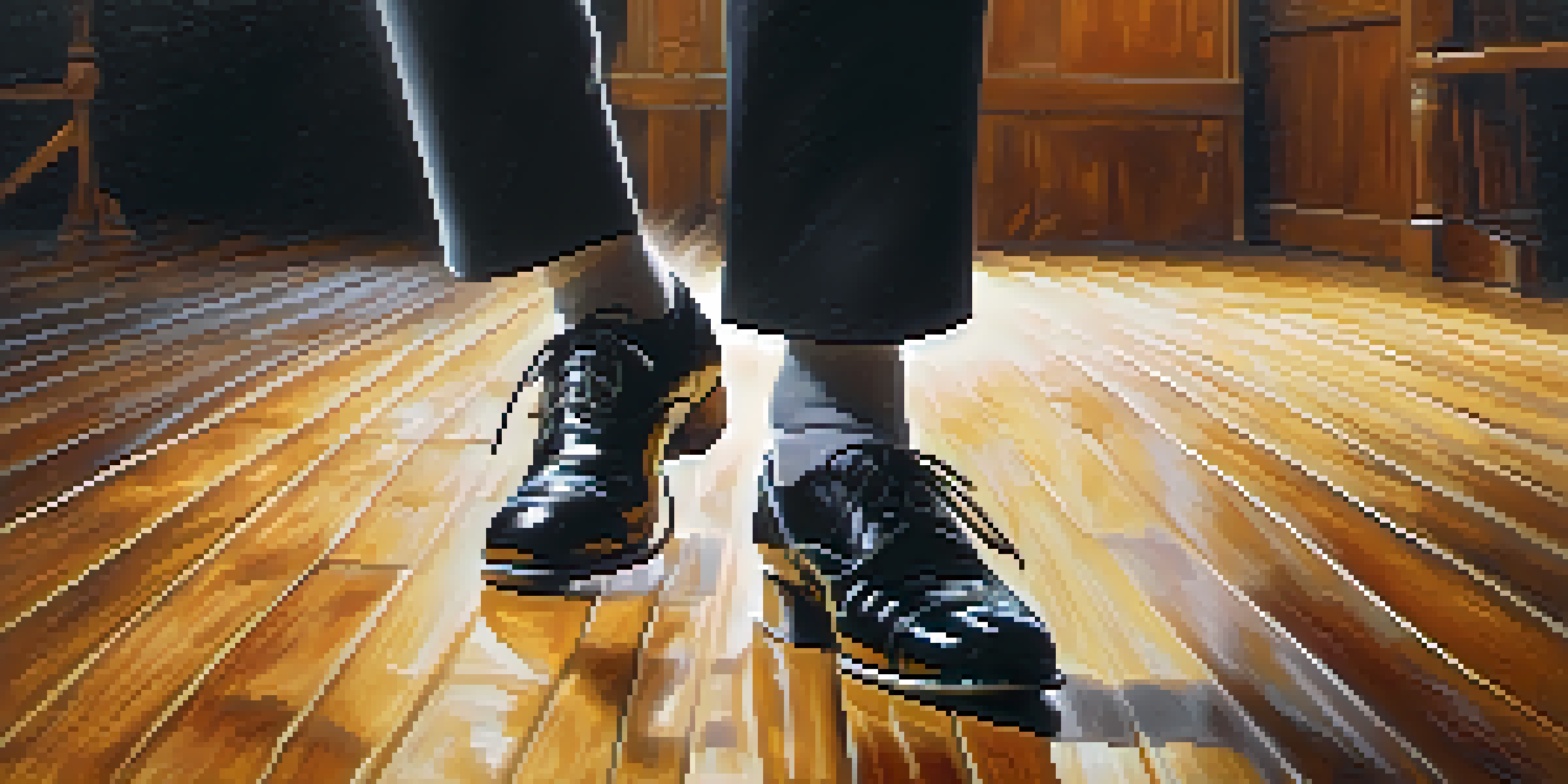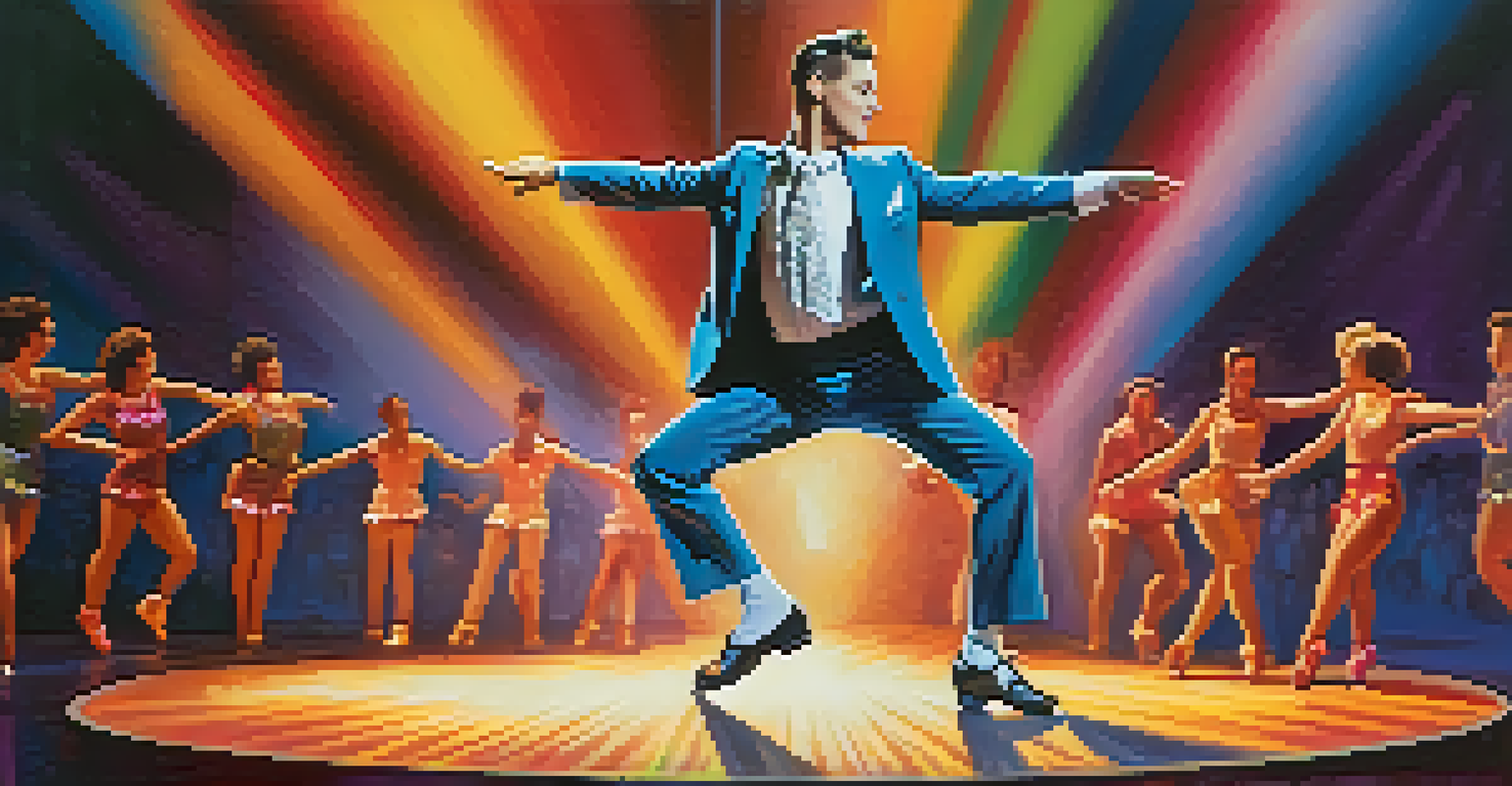Exploring Tap Dance Techniques: Rhythm and Footwork Basics

Understanding the Foundation of Tap Dance
Tap dance is a vibrant form of dance that combines rhythm and sound, making it unique. At its core, tap dance is all about the feet creating music through striking the floor. This connection between movement and sound is what sets tap apart from other dance styles, turning each performance into a rhythmic conversation.
Dance is the hidden language of the soul.
The two primary components of tap dance are rhythm and footwork, which work hand in hand. Rhythm refers to the timing and pace of your steps, while footwork involves the actual movements of your feet. Mastering both elements is essential to becoming a proficient tap dancer and expressing yourself through this art form.
As you explore tap dance, you'll find that building a solid foundation in these basics will enhance your overall performance. Think of it like learning to play a musical instrument; the more you practice the fundamentals, the more expressive and creative you'll become in your dance.
Key Tap Dance Styles and Their Characteristics
Tap dance includes various styles, each with its distinct characteristics. From the classic Broadway tap, known for its theatrical flair, to the more grounded rhythm tap, which emphasizes intricate footwork and improvisation, there's a style for everyone. Understanding these differences can help you choose the style that resonates with your personality.

One popular style is the 'soft shoe,' which focuses on smooth, flowing movements, often performed in lighter shoes. This style contrasts with 'hard shoe' tap, where dancers wear shoes with metal plates, producing a sharper, more pronounced sound. Exploring these styles can be a fun way to discover what appeals to you as a dancer.
Foundations of Tap Dance
Mastering rhythm and footwork is crucial for effective tap dancing and allows for personal expression.
As you dive into these styles, consider trying out classes or online tutorials. Each style can teach you unique techniques and rhythms that will enhance your overall tap dance skills.
Essential Rhythm Patterns for Beginners
When starting out, grasping basic rhythm patterns is crucial for developing your tap dance skills. One of the simplest patterns is the 'shuffle,' which consists of a quick brush of the ball of the foot followed by a step down. Practicing this basic rhythm will help you get comfortable with the timing and coordination needed in tap dancing.
The dance is a poem of which each movement is a word.
Another foundational rhythm is the 'cramp roll,' which involves alternating heel and toe taps in a specific sequence. This pattern not only sounds impressive but also helps improve your footwork precision. Incorporating these rhythms into your practice will build a strong rhythmic foundation.
As you become more comfortable with these patterns, challenge yourself to combine them into short sequences. This will not only improve your timing but also give you the freedom to experiment with your own unique style.
Developing Footwork Techniques for Precision
Footwork is the heart of tap dance, and developing precise techniques is key to becoming a skilled dancer. Start with basic steps like the 'step' and 'tap,' which involve placing your foot down and lifting it for sound. These simple movements form the building blocks of more complex combinations.
As you progress, focus on refining your foot placement and weight transfer. Being aware of how your feet interact with the floor can enhance your sound quality and overall performance. Think of your feet as instruments; the more control you have, the more beautiful the music you create.
Exploring Tap Dance Styles
Different tap dance styles, such as Broadway and rhythm tap, offer unique characteristics that can resonate with individual dancers.
Practicing with a metronome can also help you stay in sync with your rhythms. This tool is invaluable for developing consistency and precision in your footwork, ensuring that every step you take resonates with clarity.
The Importance of Timing and Musicality
Timing in tap dance is everything; it determines the flow and feel of your performance. Developing a good sense of timing means understanding when to strike your foot and how to sync your movements with the music. This connection transforms your dance into a captivating rhythmical experience.
Musicality goes hand in hand with timing, as it refers to your ability to interpret and express music through your dance. Listening to a variety of music styles can help you develop this skill, allowing you to feel the rhythm and adapt your footwork accordingly. The more you immerse yourself in music, the more naturally your movements will align with it.
To enhance your musicality, practice dancing to different genres. From jazz to funk, each style offers unique rhythms and tempos, broadening your understanding and appreciation of music in relation to tap dance.
Practicing Tap Dance: Tips for Improvement
Consistent practice is the key to improving your tap dance skills. Set aside dedicated time each week to work on your techniques, focusing on both rhythm and footwork. Incorporate a variety of exercises, such as drills for specific patterns, to keep your practice sessions engaging and effective.
Recording your practice sessions can provide valuable feedback. Watching yourself dance allows you to identify areas for improvement, such as timing, posture, and foot placement. This self-awareness is essential for growth as a dancer.
Practicing for Improvement
Consistent practice, recording sessions, and engaging with a tap dance community are essential for skill enhancement.
Additionally, consider joining a tap dance community, whether online or in-person. Engaging with fellow dancers can provide motivation, inspiration, and opportunities to learn from each other, making your tap dance journey even more enjoyable.
Exploring Advanced Techniques and Combinations
Once you've mastered the basics, it's time to explore advanced techniques and combinations that can elevate your tap dance skills. Techniques like the 'time step' and 'wings' introduce complex rhythms and foot movements, pushing your abilities to new heights. These advanced steps not only sound impressive but also add depth to your performances.
Combining different rhythms and footwork patterns can create unique sequences that showcase your individuality as a dancer. Experimenting with improvisation during practice can lead to exciting discoveries and personal expression in your tap dance style.

Remember, every advanced dancer started as a beginner. Embrace the journey of learning and growing, and don’t be afraid to challenge yourself. The more you push your boundaries, the more rewarding your tap dance experience will be.